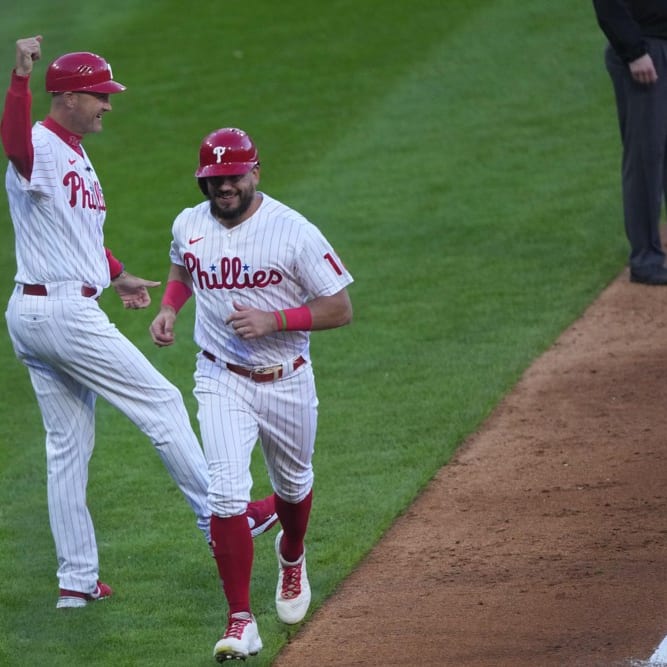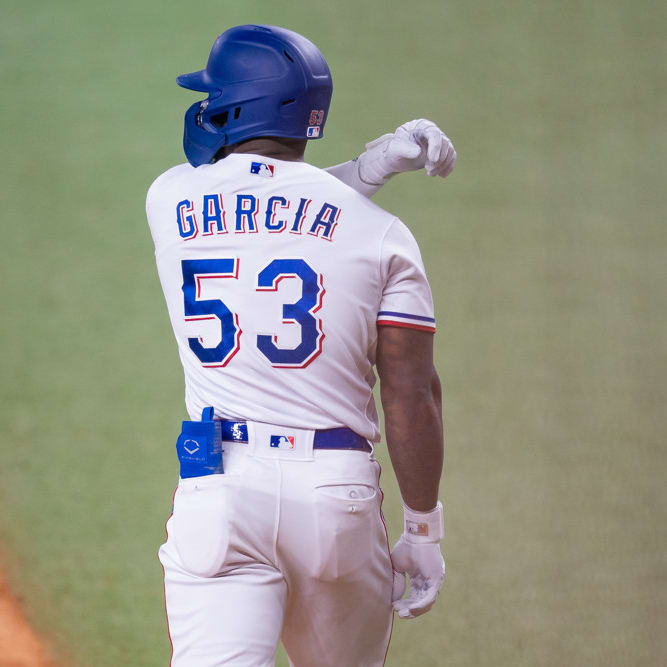This article is part of our The Long Game series.
Stuck In the Middle with You
With the first month of the season drawing to a close, it's a good time to evaluate your team's performance and determine whether or not you should commit to playing for this season or next. In many cases, the decision will be easy. If you're at the top of the standings or within spitting distance of the leader, obviously you're going to be going for it. If you're mired at the bottom of the table, you're probably already looking ahead to 2014. But what do you do if you're somewhere in the middle, where it's easy to convince yourself that a few good weeks could put you right back in the title hunt... regardless of how likely those good weeks are to happen?
While sitting back, doing nothing and giving your roster a little more time to make the picture clearer isn't always the wrong decision, every week is precious and you shouldn't let too many of them tick by unnecessarily if you can help it. There are some tools you can use to evaluate whether your team's simply been unlucky so far and is still in a position to compete, and allow you to get a jump on your procrastinating competition:
Plan for Regression, Not Miracles
When you're looking over your roster to determine whether you've got a chance to make a move in the standings, the outliers always jump out at you. Chris Davis is obviously hitting way over his head when
Stuck In the Middle with You
With the first month of the season drawing to a close, it's a good time to evaluate your team's performance and determine whether or not you should commit to playing for this season or next. In many cases, the decision will be easy. If you're at the top of the standings or within spitting distance of the leader, obviously you're going to be going for it. If you're mired at the bottom of the table, you're probably already looking ahead to 2014. But what do you do if you're somewhere in the middle, where it's easy to convince yourself that a few good weeks could put you right back in the title hunt... regardless of how likely those good weeks are to happen?
While sitting back, doing nothing and giving your roster a little more time to make the picture clearer isn't always the wrong decision, every week is precious and you shouldn't let too many of them tick by unnecessarily if you can help it. There are some tools you can use to evaluate whether your team's simply been unlucky so far and is still in a position to compete, and allow you to get a jump on your procrastinating competition:
Plan for Regression, Not Miracles
When you're looking over your roster to determine whether you've got a chance to make a move in the standings, the outliers always jump out at you. Chris Davis is obviously hitting way over his head when it comes to batting average, while even if Matt Kemp is hiding an injury or something he can't possibly remain that bad. Mentally adjusting for the expected regression in those players doesn't require much discipline. It's the guys in between that are going to trip you up. Of course Davis won't keep hitting .382 because almost nobody hits .382. Lots of guys hit .283 though, so why can't Mark Reynolds be one of them? I mean, he did hit .279 that one time. So what if that's probably 50 points higher than you expected when you rostered him, look at his improved contact rate! He's clearly made some sort of adjustment that will keep him from being a liability in batting average going forward, right?
Humans are very adept at finding information that reinforces their beliefs, and ignoring information that doesn't. It's all too easy to convince ourselves that when one of our players does something unexpectedly good, it means they've figured something out and will continue to perform at that level, invoking names like Jose Bautista and Ben Zobrist when we do so. The point is not whether any individual player can maintain what they've accomplished through the first three weeks of the season. Maybe Reynolds will pop for a solid average by season's end after all. But when you bought the guy 20 games ago you had certain expectations for him and with another 140 games to go there's probably no reason to abandon those expectations now. (If you just read Nate Silver's The Signal and the Noise and are feeling frisky, and want to bust out Bayes' Theorem to try and determine the odds that those 20 games will be representative of the next 140, be my guest. The results will depress you.)
In a sense, this is the inverse of the standard Gambler's Fallacy in fantasy baseball. When people bring up the Gambler's Fallacy, it's usually in the context of the belief that a player will 'balance out' a slump with a later hot streak to get their numbers back in line with their projections*, in much the same way that someone might believe a flipped coin is 'due' to land on tails after 10 heads in a row. Gamblers bet hot streaks too though, and it's just as silly to assume that 11th flip will also be heads because the coin is "on a roll" landing heads.
The bottom line is this: when figuring out your roster's strengths and weaknesses, you don't yet have enough new information to radically alter the projections for most of your players, obviously excepting players in new roles or those who have serious injuries. Expect them to be the same guys you thought they were on April 1.
* - I actually somewhat disagree with that application of the Gambler's Fallacy, but that disagreement comes down to whether you view a player's yearly projection as the composite total of a series of independent outcomes, or a single outcome of its own. But that's a different discussion.
The Cavalry's Coming For Everybody
Speaking of injured players, you've probably got one or two, and probably have a very good idea of when they're coming back. Maybe you're lagging a bit in the power categories, but you have Mark Teixeira on your bench who you'll be plugging in for a temp like Shelley Duncan in a few weeks. You'll be fine, right?
Maybe you will. Or maybe the teams you're chasing in HR and RBI have Curtis Granderson and Brian McCann on their benches. And the guy chasing you in those categories has Wil Myers on his bench champing at the bit for the Super Two deadline to get here.
Again, we're back to our uncanny ability to see what we want to see and tune out what we don't. It's not enough to look at your own DL and minors and add reasonable projections for them to your bottom line. Your opponents have a DL and minor league system too, and if you don't factor them in you're setting yourself up for a mistake.
Trade Bait or Roster Chum?
Let's say you do determine that you can still go for the gold. You've got a bunch of players who seem like legitimate underperformers, some reinforcements coming from the DL in the near future, and the teams you're jockeying for position with are all riding closer to the top of their range of expected outcomes than the bottom.
There's one small problem: you're still behind them. The season's about 15% over, and you're in a hole. If you really think you can win it, sitting back and waiting for the standings to normalize based on your projections might not be good enough because those other teams have already banked a not insignificant amount of production. If you're going to close the gap you're probably going to have to do some trading, and that means deciding which of your assets are movable, which are untouchable, and which are simply going to be expensive to pry away from you.
In some setups this is an easier thing to figure out than others. Leagues with deep minor league systems allow you to keep a nice store of high profile prospects that are far enough away from the majors that dealing them won't impact you in the short term. But even if you do have elite prospects to deal, that probably won't be enough. You're going to have to evaluate your major league players, not just in terms of what they can do for you this season, but what they might fetch in a trade.
Making early season trades in keeper leagues is hard. Most clubs see themselves as still in the hunt for the money (whether that's a realistic goal or not) and won't want to dump this year's production for next year's keepers. Even the teams who have resigned themselves to playing for next year may not want to 'set the market' by pulling off an early deal and establishing this year's stars-for-keepers exchange rate (every league has one), preferring to wait for someone else to do it. So if you can't make a big splash sort of trade, you're going to have to get aggressive and creative.
Take a look at your fellow owners in the middle of the standings. Maybe your team has a slight surplus of starting pitching but needs steals, and another owner trying to make up ground has the opposite problem. An old fashioned 'my strength for yours' deal could make sense for both of you, and if you need to sweeten the pot by offering a player with a little more keeper value than the one you're getting, don't hesitate to do it. Remember, you've already committed to going for it, so a 'win' in a trade like this means adding the player you want as soon as possible, not necessarily getting the optimal return. The earlier you acquire the talent you think you need to close the gap in the standings, the more production you get out of them.
If there are no obvious matches in that respect, cast a wider net. Identify the single most coveted keeper you have on your roster (Bryce Harper, Matt Moore, whoever), the one who's not only young and has a great pedigree but is also putting up big numbers this season, and start dangling him to the teams with talent that can help you the most. One of them might be willing to overpay on the "getting the best player wins you the deal" principle. Or, instead of waiting for those DL'ed guys to return, see if you can swap them for a slightly less impressive but healthy name, especially if you were able to get the 'name brand' injured guy at enough of a discount that they have keeper value. Under normal circumstances you'd never trade Granderson for, say, Nick Swisher, but those extra weeks of healthy production from Swisher will make up the difference in their overall value at season's end, and getting his bat in your lineup now will help you start making your climb.
And if you don't have any elite prospects, stud keepers or discounted injured players to peddle? If you don't see any obvious 'strength for strength' trade partners, or all your pitches get rebuffed or fall on deaf ears? Well then, it might be time to fess up and admit that maybe this isn't your year after all. The stats might say you have a window of opportunity, but it's closing rapidly and if you can't make a move soon, there's no point making one at all.
Of course, if you're not playing for this year you should be playing for next year, which brings a whole different set of tools and strategies into play, but those can wait for next week.









